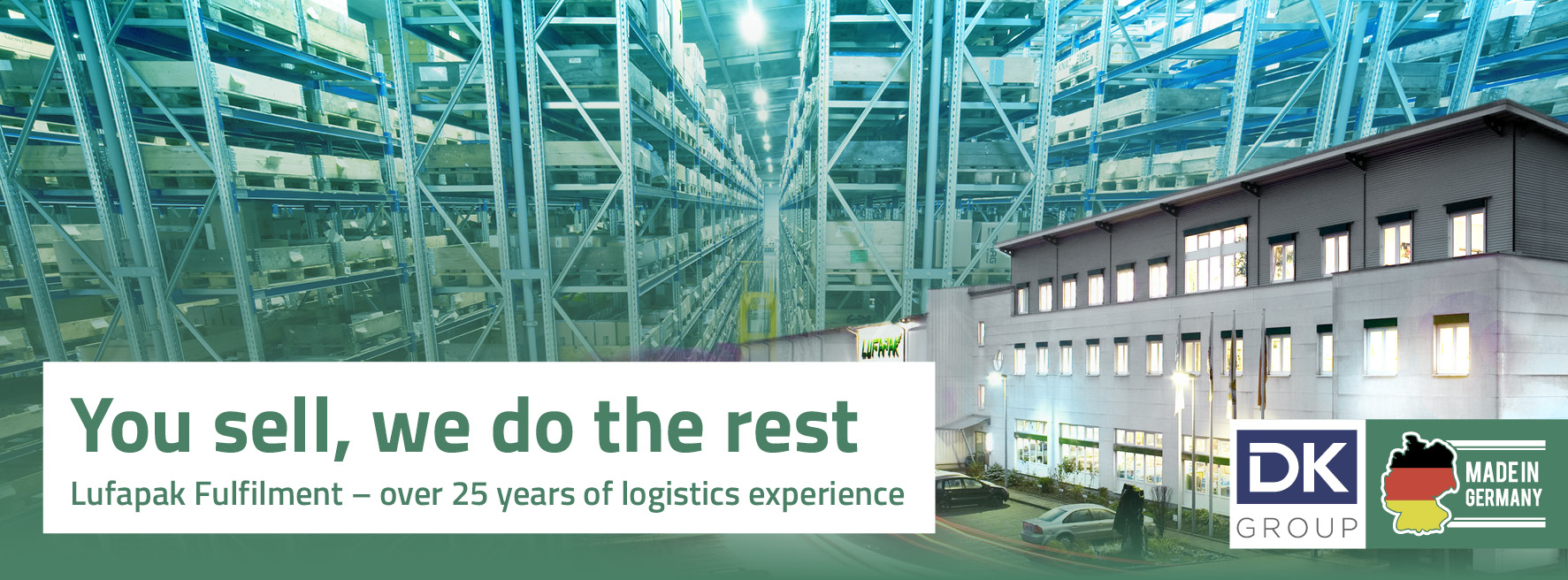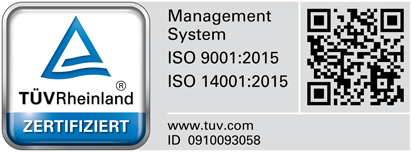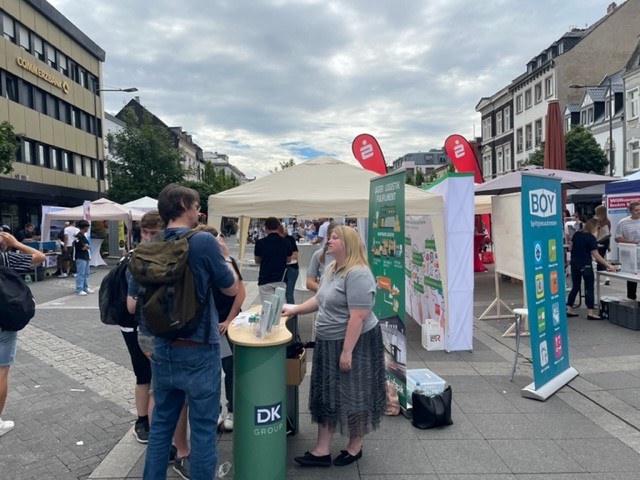sales@lufapak.de +49 2631/384-0 Contactform
Exhibition logistics encompasses all logistical processes that are necessary to ensure successful participation in an exhibition. This begins with planning and preparation, continues with the transport of exhibits and extends to the assembly and dismantling of the exhibition stand and the storage of materials. The central idea behind Exhibition logistics is to ensure that all the goods required are available at the right time, in the right place and in perfect condition.
Carefully planned exhibition logistics are crucial to the success of a trade fair participation. After all, even the best presentation and the most innovative products cannot be effective if they do not arrive at the trade fair venue on time or are damaged. Aspects such as compliance with customs regulations at international trade fairs, efficient utilisation of the available space and coordination of the set-up and dismantling processes also play a key role.
Another important point is on-site personnel management: employees need to know exactly when and where they have to carry out which tasks in order to guarantee a smooth process. This is where modern technologies and digital solutions come into play, which can support and optimise the various logistical processes.
Planning and preparation in Exhibition logistics
Successful Exhibition logistics begins with thorough planning and preparation. The first steps include defining clear objectives: What does the company want to achieve at the trade fair? These can be goals such as increasing brand awareness, generating leads or launching new products. These goals largely determine the further logistical requirements and activities.
Another important component is budget planning. All relevant cost factors must be taken into account, including transport costs, stand hire, set-up and dismantling costs and any storage costs. A realistically defined budget helps to avoid financial surprises and enables funds to be utilised efficiently.

Drawing up a detailed timetable is also essential. This plan should include all important milestones and deadlines – from the start of the preparations to the completion of the follow-up after the trade fair. This includes, for example, booking the exhibition stand, ordering and delivering exhibits and organising transport. A well-organised schedule ensures that all steps are completed on time and in a coordinated manner.
It is also important to check all the necessary authorisations and regulations in advance, especially if the trade fair is taking place abroad. These include customs regulations, import regulations and safety requirements. Clarifying these points at an early stage can prevent delays and complications during the trade fair.
Transport and handling of exhibition goods
A central aspect of Exhibition logistics is the transport and handling of exhibition goods. This process begins with the careful packaging of the exhibits to ensure that they are not damaged during transport. The selection of suitable packaging materials and the correct securing of the goods play a decisive role here.
The transport itself must be well planned and organised. It is important to choose reliable means of transport, be it by lorry, plane, ship or a combination of several modes of transport. The choice depends on various factors, such as the location of the trade fair, the dimensions and weight of the goods and the time frame. Forwarding companies that specialise in Exhibition logistics can provide valuable support here.
Another important point is scheduling. The exhibition goods must arrive at the venue on time to ensure a smooth set-up. Delays can cause considerable stress and jeopardise the entire trade fair participation. It is therefore important to plan realistic time slots and allow for possible delays by allowing buffer times.
Once on site, the exhibits need to be transported safely and efficiently to the stand and positioned there. This often requires special lifting and transport equipment, such as forklift trucks or pallet trucks, especially when heavy or bulky goods are involved. Close coordination with the trade fair organisers and the on-site set-up team is essential to ensure that everything runs smoothly.
Additional services such as the temporary storage of packaging materials during the trade fair or the handling of returns after the event should also be planned. This includes the safe storage and, if necessary, repackaging of the goods for return transport.
Construction and dismantling of the exhibition stand
The set-up and dismantling of the exhibition stand are critical phases in Exhibition logistics that require precise planning and coordination. An efficient process ensures that the stand is ready on time and without any problems and that it is dismantled quickly and properly after the trade fair.
Construction of the exhibition stand
Stand construction begins with detailed stand planning. This includes the layout of the stand, the positioning of the exhibits, lighting, electronics and all other materials and furniture required. It is important to draw up a precise plan in advance and coordinate it with all parties involved.
Professional assembly teams take over the assembly of the stand structures, the installation of the technical equipment and the positioning of the exhibits. It is crucial that all components are on site on time and delivered in perfect condition. Coordination between the transport services, the set-up team and the trade fair organisers must run smoothly.
Safety aspects should also be taken into account during set-up. This includes compliance with safety regulations, the correct use of tools and equipment and accident prevention measures. A safe set-up not only protects the staff, but also minimises the risk of damage to the exhibits.
Dismantling the exhibition stand
Once the trade fair is over, the stand is dismantled. This process should be just as well organised as the set-up. Firstly, all exhibits must be carefully packed and prepared for return transport. It is important to ensure that all packaging materials and transport containers are ready and in good condition.
The dismantling team should know exactly in which order the work is to be carried out in order to ensure an organised and efficient process. All components of the stand must be carefully dismantled and stored so that they can be reused for future trade fairs.
Safety also plays a central role during dismantling. Wearing protective clothing and adhering to safety guidelines are mandatory in order to avoid accidents.
Time management and follow-up
Precise time management is essential for both set-up and dismantling. Tightly synchronised schedules and clear task allocations ensure that all work is completed on time. Buffer times can help to compensate for unforeseen delays.
After dismantling, all materials and equipment used should be checked and serviced or replaced if necessary. Thorough follow-up work ensures that everything is in perfect condition for the next trade fair.
Efficient stand set-up and dismantling are essential components of a successful trade fair participation. They enable a professional appearance and contribute significantly to the overall success of the event.
Storage and inventory management
Efficient storage and inventory management are essential aspects of Exhibition logistics, ensuring that all necessary materials are optimally managed before, during and after the trade fair. A well-designed system for storage and inventory management goes a long way towards making the entire process smooth and cost-efficient.
Storage before the trade fair
Before the trade fair, all exhibits, materials and stand components must be stored safely. It is important to choose suitable storage facilities that offer sufficient space and fulfil the necessary conditions such as temperature and humidity control. Sensitive materials should be specially protected and, if necessary, stored in special containers.
Efficient inventory management begins at this stage. All materials should be inventoried and recorded in a warehouse management system. This enables accurate tracking and prevention of loss or damage. Regular stock checks ensure that everything is properly stored and easy to find.
Storage during the trade fair
During the trade fair, temporary storage is often required to keep packaging materials, spare parts and additional exhibits close to the stand. This temporary storage should be well organised to ensure quick access and efficient handling. In many exhibition halls, special storage rooms or areas are available for this purpose.
It is important that the storage staff know exactly where which materials are located and how they can be transported to the stand quickly and safely. A well-organised interim storage facility minimises the time needed to transport spare parts or additional materials and thus supports smooth trade fair operations.
Storage after the trade fair
After the trade fair, all materials must be safely stored again. The return transport of exhibits and stand components should be well planned to avoid damage. After returning to the warehouse, all materials should be checked, cleaned and, if necessary, repaired before being put into storage.
Inventory management after the trade fair includes recording all returned materials and their condition. This is important in order to identify and carry out any necessary repairs or replacements in good time. Careful documentation also helps to increase efficiency at future trade fairs and save costs.
On-site personnel management and Exhibition logistics
A successful trade fair appearance depends not only on logistical planning and material resources, but also on efficient personnel management. Coordinating staff on site and managing the associated logistical tasks are crucial to ensuring that everything runs smoothly during the trade fair.
Planning and organising personnel
The first step in personnel management is the careful planning of staff assignments. It should be clearly defined which employees are responsible for which tasks. This includes organising them into different teams such as the set-up and dismantling team, stand personnel, technicians and support staff. Each role should be assigned clear tasks and responsibilities.
A detailed schedule is essential to ensure that all tasks are completed on time and efficiently. Breaks and shift changes should also be planned to evenly distribute the workload and maintain staff efficiency.
Training and briefing
Before the start of the trade fair, it is important that all employees receive comprehensive training. This includes product-specific knowledge as well as information about the trade fair itself, the stand set-up and the expected visitor flows. A detailed briefing ensures that everyone involved is well prepared and knows what is expected of them.
Coordination and communication
Coordination and communication play a central role during the trade fair. A defined communication system ensures that all employees can be reached at all times and that important information can be passed on quickly. This can be done using mobile devices, radios or internal communication platforms.
A central coordinator on site should monitor the processes and act as a point of contact for all team members. This coordinator keeps track of the various tasks and ensures that all processes run smoothly.
Logistical tasks on site
On-site logistics tasks include managing trade fair materials, handling spare parts and looking after the technical equipment. The logistics team should ensure that all materials are available at the stand on time and in perfect condition. This also includes the receipt of deliveries, safe storage and transport of materials to and from the stand.
Another important task is the management of visitor flows. Stand personnel should be prepared to welcome visitors professionally, answer questions and approach potential interested parties in a targeted manner. Good visitor support contributes significantly to the success of the trade fair presentation.
Follow-up and feedback
At the end of the trade fair, all employees should be involved in dismantling the stand. A debriefing helps to share experiences, identify potential for improvement and gather valuable feedback for future trade fair participations.
Employee feedback can provide important insights into the effectiveness of the strategies and processes used and contribute to the continuous improvement of Exhibition logistics.
Cost control and budget management in Exhibition logistics
Well thought-out cost control and effective budget management are crucial in order to optimise the use of financial resources when planning and implementing a trade fair appearance. It is not just a matter of keeping an eye on expenditure, but also of taking proactive measures to minimise costs and use the budget efficiently.
Creating a detailed budget
The first step in budget management is to create a detailed budget that includes all expected cost items. These cost items include:
- Stand hire: The cost of renting the exhibition stand.
- Transport costs: Expenses for transporting exhibits and materials to and from the trade fair.
- Set-up and dismantling costs: Costs for setting up and dismantling the exhibition stand, including any external service providers.
- Storage costs: Costs for the storage of materials before, during and after the trade fair.
- Personnel costs: Wages and salaries for stand personnel and costs for their training.
- Insurance costs: Expenditure on insurance to cover damage or loss.
- Marketing and advertising materials: Costs for brochures, flyers, promotional gifts and other marketing materials.
- Catering and accommodation: Costs for catering and accommodation for staff during the trade fair.
A comprehensive budget provides a clear overview of planned expenditure and forms the basis for monitoring and controlling costs.
Monitoring expenditure
Expenditure should be continuously monitored throughout the preparation and realisation phase of the trade fair. This can be done through the use of financial software or specialised expense management tools that provide real-time data and help to maintain an overview.
Regular budget reconciliations are necessary to determine whether the actual expenditure corresponds to the planned costs. Deviations should be analysed immediately and corrective action taken if necessary.
Avoiding unexpected costs
To avoid unexpected costs, it makes sense to implement risk management strategies. This includes identifying potential risk factors, such as delays in transport, damage to exhibits or additional costs for on-site services. Setting aside a contingency budget can help to cover such unforeseen expenses without blowing the entire budget.
Selecting cost-efficient providers
Choosing the right service providers plays a key role in controlling costs. Compare quotes from different providers and select those that offer the best value for money. Long-term partnerships with reliable providers can also lead to more favourable conditions and further reduce costs.
Follow-up and evaluation
Once the trade fair is over, all expenditure should be reviewed again and compared with the original budget. A detailed evaluation of the financial aspects of the trade fair appearance provides valuable insights and helps to plan future budgets more realistically.
Feedback from all those involved can also help to identify inefficient processes and uncover opportunities for improvement.
Conclusion: Successful Exhibition logistics as a competitive advantage
In conclusion, it can be said that well-organised exhibition logistics contribute significantly to the overall success of a trade fair appearance and can give the company a significant competitive advantage. From planning, transport and set-up to cost control and follow-up – every phase of Exhibition logistics must be carefully thought through and efficiently implemented.
Contribution to overall success
- Smooth processes: Well-organised logistics ensure that all materials and exhibits arrive at the trade fair location on time and undamaged. This minimises stress and enables a smooth set-up.
- Professional appearance: Efficient stand construction and proper placement of exhibits contribute to a professional appearance that impresses potential customers and partners.
- Cost efficiency: Careful cost control and strict budget management keep expenses in check, which increases the profitability of the trade fair appearance and prevents financial surprises.
- Effective staff management: Proper planning and coordination of staff ensures that all tasks are completed efficiently and that the team works together optimally, which increases overall performance.
- Flexibility and adaptability: Good Exhibition logistics make it possible to react quickly to unforeseen challenges and make adjustments without disrupting the overall process.
- Sustainability: Well-planned logistics processes can also contribute to sustainability by avoiding unnecessary transport and utilising resources efficiently.
Competitive advantage
- Increased visibility: A well-planned and executed trade fair appearance increases the visibility of the company and strengthens its brand awareness.
- Improved customer loyalty: Professional presentation and efficient processes leave a positive impression on visitors, which promotes customer loyalty.
- Higher lead generation: A well-organised stand attracts more visitors and offers the opportunity to generate more high-quality leads.
- Improved business relationships: Reliability and professionalism build trust with partners and potential customers, which promotes long-term business relationships.
- Successful Exhibition logistics is no coincidence, but the result of careful planning, precise execution and continuous optimisation. It not only helps to ensure a smooth and efficient trade fair presence, but also to optimise the use of financial resources and exploit the full potential of trade fair participation.
By combining all these factors, well-organised exhibition logistics become a real competitive advantage that sets the company apart from the competition and ensures sustainable success at trade fairs.
Contact us now and get advice


